Geography 111:
Introduction to Physical Geography and Environmental Studies
...to Geog 111 Main Page and Course Description
...to Geog 111 Syllabus
...to Geog 111 Course Schedule and Lecture Outlines
...to Geog 111 Course Project
Geog 111 Lecture Outline: Introduction to Earth's Atmosphere
Update: 9/20/05
Introduction to the Atmosphere
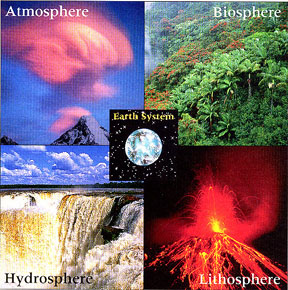
- The Four Earthly Spheres
One of the unique characteristics of earth as a planet: its atmosphere
Air: same as atmosphere
- a mix of different gasses
- solid and liquid particles
- invisible, no smell or taste
The atmosphere completely surrounds the earth
- role of gravity
- dynamic and flexible
Dimensions of the atmosphere
- distance outward
- mass (weight): where concentrated
- McKnight fig 3.2: atmospheric mass
Atmosphere extends slightly below the surface of the Earth
1. Composition of the Atmosphere
What air is made of:
1a. The Gasses
McKnight fig 3.3: nitrogen, oxygen, and others (table 3.1 for more detail)
Nitrogen:
- generated and added to atmosphere: examples
- removed from the atmosphere: examples
- nitrogen cycle
Oxygen
- generated and added to atmosphere: examples
- removed from atmosphere: examples
- oxygen cycle: also a balance
Water vapor in the atmosphere
- significant influence on weather and climate: why?
Carbon dioxide in the atmosphere also influences climate: why?
- normally in balance: but global warming...
McKnight fig 3.4 (not in current text): ozone
Ozone: comprised of 3 joined oxygen molecules
- ozone layer (9 to 15 miles up): where it is and what it does
- human impact: in the news
Sum: various gasses in various amounts in the atmosphere
- normally a dynamic but stable system
1b. The Particles
Non gasses: mostly water and ice
- McKnight fig 3.4: also dust
Particulates: sources
Particulates affect weather in two ways
- hygroscopic effect: what is it?
- absorb or reflect sunlight: effects
2. Vertical Structure of the Atmosphere
- what happens as we move from earth up into the atmosphere?
2a. Atmospheric Temperature
McKnight fig 3.5
Named thermal layers (-spheres) of the atmosphere
- troposphere, stratosphere, mesosphere, thermosphere, exosphere
Names for the boundaries (-pause)
- tropopause, stratopause, mesopause
Troposphere and Tropopause
- greek word for 'turn'
- characteristics
- McKnight fig 3.6: variation in troposphere around the earth
- McKnight fig 3.5: Zig zag
Stratosphere and Stratopause
- greek word for "cover"
- characteristics
Mesophere and Mesopause
- greek word for "middle"
- characteristics
Thermosphere and Exosphere
- above 50 miles: characteristics
Temperature variations and altitude
- our experience: troposphere (colder higher) only
- warmth in troposphere: from...
- warmth in stratopause: from...
2b. Atmospheric Pressure
- Atmospheric pressure: weight of the overlying air
- McKnight fig 3.7: variations in atmospheric pressure
- atmospheric pressure plays a large role in weather and climate
2c. Atmospheric Composition
McKnight fig 3.9: the Homosphere
- Composition of air in the first 50 miles (homosphere) is uniform: characteristics
- Above 50 miles, more variability in atmospheric composition: heterosphere: characteristics
McKnight fig 3.11
- Ozonosphere: ozone in greatest concentration
- Ionosphere: electrically charged particles
McKnight fig 3.12: Sum of Atmospheric Layers
3. Weather and Climate
- atmosphere is a dynamic system: why?
- distinguishing weather and climate is a matter of scale and time
Weather: short term atmospheric conditions in a given, limited area
Climate: aggregate of day-to-day weather conditions over a long period of time
- climate shapes human activity: examples
- climate shapes physical landforms: examples
- climate can also be shaped by human activity: examples
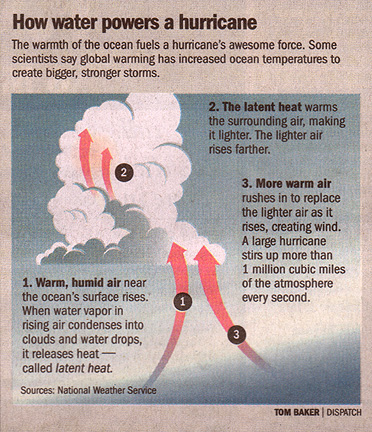
- climate can be shaped by physical landforms: examples
Dr. Hickcox's Geog 375. Weather and Climate. The elements of
meteorology, emphasizing types of weather experienced during the course of a
year. Content includes cloud types, warm and cold fronts, and severe weather
phenomena such as thunderstorms, tornadoes, and hurricanes. A classification of
world climates is presented.
4. Elements of Weather and Climate
Four elements as the basis of weather and climate:
- DESCRIBE weather and climate
- temperature, pressure, wind, and moisture content
Changes in the four elements of weather and climate are driven by several controls
- latitude, atmospheric circulation, ocean circulation, distribution of
land and water, elevation of landforms, topographic barriers
- they are interrelated
- they drive changes in the elements and lead to weather and climate
- EXPLAIN weather and climate
4a. Latitude
- McKnight fig 3.14: differential heating

 Same amount of energy spread out over larger area north and south of equator.
Same amount of energy spread out over larger area north and south of equator.
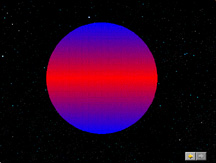 Solar radiation distribution varies over earth's surface.
Solar radiation distribution varies over earth's surface.
4b. General Atmospheric Circulation
- McKnight fig 3.13: General Circulation

- why these patterns?
- Expand explanation in Ch. 3 (reviewed in McKnight Chapter 5: pp. 111-123)
- complicated: sketch in notes!
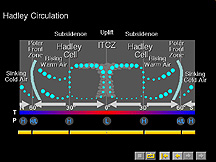 Hadley Circulation
Hadley Circulation
- PDF) Hadley Circulation
- equator: hot air rises
- mid latitudes: cool air sinks and reheats: rises again
- poles: cool air sinks
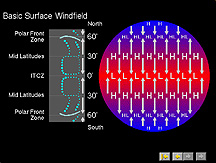 Basic Surface Windfield
Basic Surface Windfield
- PDF) Basic Surface Windfield
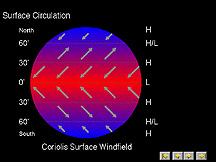 Coriolis Effect
Coriolis Effect
Coriolis effect: rotation of earth deflects wind; results in
deviation from north/south flows
4c. General Circulation of Oceans
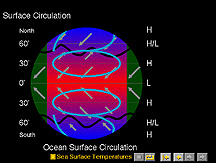 General Ocean Surface Circulation
General Ocean Surface Circulation
- PDF) General Ocean Surface Circulation
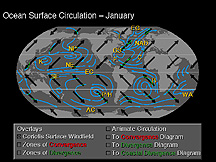 Actual Ocean Circulation: January
Actual Ocean Circulation: January
- McKnight fig 3.15: ocean currents: effects

- McKnight fig 4.27: more detail

- warm currents off eastern coasts: shapes climate, weather
- cool currents off western coasts: shapes climate, weather
4d. Distribution of land and water
- Oceans heat and cool more slowly than land: seasonal effects
- Oceans also provide moisture for atmosphere
4e. Elevation of Landforms
- decrease upward of temperature, pressure, and moisture content: lower higher
4f. Topographic Barriers
McKnight fig 3.17: Orographic Effect
- orographic precipitation (ch. 6 p. 154)
- McKnight fig 6.26b (not in current ed.): orographic precipitation
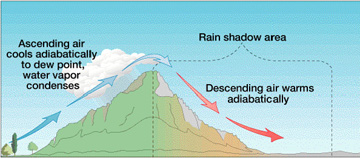
- McKnight 6.31: (January rainfall)

These six factors drive day to day weather and longer term climate patterns
Sum: The Earth's Atmosphere
Very brief overview of the atmosphere, climate, and weather
- 1. Composition of the Atmosphere
2. Vertical Structure of the Atmosphere: variations (up/down) in temperature,
pressure, composition of atmosphere
3. Weather and Climate
- Four elements describe weather and climate: temperature, pressure, wind, and
moisture content
- Six controls drive changes in (explain) weather and climate
- latitude
- general atmospheric circulation
- ocean circulation
- distribution of land and water
- elevation of landforms
- topographic barriers
Basic environmental phenomenon which are necessary to understand landforms
- ex) erosion and weathering of landforms due to climate
McKnight fig 8.5: Major Climate Zones on Earth

- related to landforms and processes which shape landforms
- closely related to biomes (climate + life forms) regions
Also vital to understand: the role water plays in shaping landforms
- McKnight fig 9.5: the hydrosphere

E-mail: jbkrygier@owu.edu
...to Geog 111 Main Page and Course Description
...to krygier teaching page.
...to krygier top page.
OWU Home
OWU Geology and Geography Home




 Same amount of energy spread out over larger area north and south of equator.
Same amount of energy spread out over larger area north and south of equator. Solar radiation distribution varies over earth's surface.
Solar radiation distribution varies over earth's surface.
 Hadley Circulation
Hadley Circulation Basic Surface Windfield
Basic Surface Windfield Coriolis Effect
Coriolis Effect General Ocean Surface Circulation
General Ocean Surface Circulation Actual Ocean Circulation: January
Actual Ocean Circulation: January




